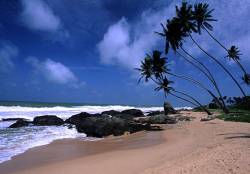
Tourism arrives have risen for 10 consecutive months and were up 50 per cent in March, compared to the same period last ye
Indian tourists took the top slot with 8,607 visiting Sri Lanka, with tourists from the United Kingdom (8,559) and Germany (5,305) following. With the increase in operations of the low cost carrier, Air Asia, arrivals from Malaysia to saw a healthy increase.
Dilip Mudadeniya, Director General Marketing, Sri Lanka Tourism Promotion Bureau, said that this healthy trend would continue in the future too. “This positive sentiment is due to peace and the removal of travel advisories and we expect this healthy trend to continue,” he said.
But according to Ajit Gunawardene, chief executive of John Keells, Sri Lanka’s largest hotel group, if the tourism economy continues to grow at such rates there will be an occupancy shortage within two years.
Sri Lanka’s tourist infrastructure can handle up to 800,000 visitors a year, comfortably meeting expected demand this year of 500,000.
However within the next two years, visitors arrivals are expected to double and then double again two years later to 2 million. He suggests that unless the country embarks on a hotel construction boom it will fail to meet demand.
“This gives you an indication of the type of momentum we want to maintain,” Mr Gunawardene said.
He said John Keells had begun renovating hotels and building more to meet the tourism boom.
It is currently upgrading its large hotel in Colombo, overhauling one in Trincomalee in the war-torn east and building tourist accommodation in the south.
John Keells also has a firm eye on the planned expansion of Colombo’s port, which is strategically placed on shipping lanes between Europe, the Middle East and China.
The group is expected to bid with its partner Denmark’s Maersk for an additional terminal, which would make Colombo the largest port in south Asia.
